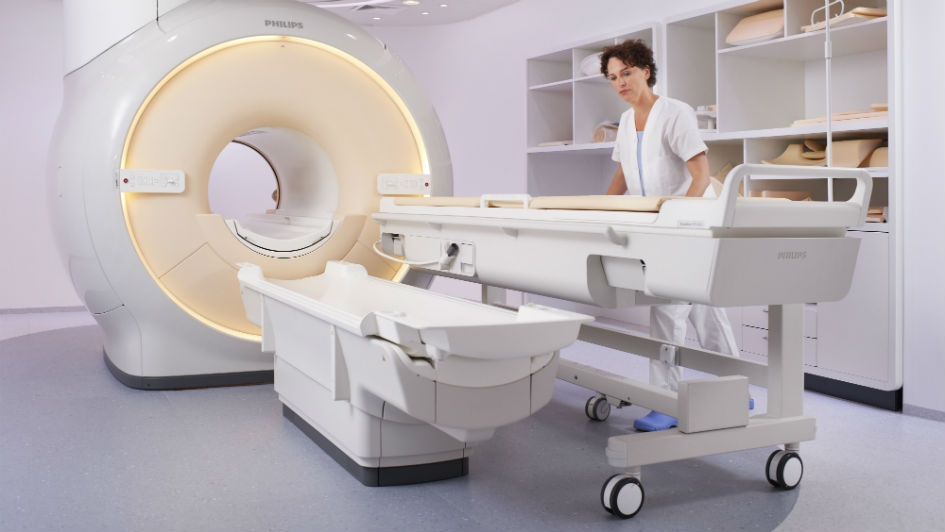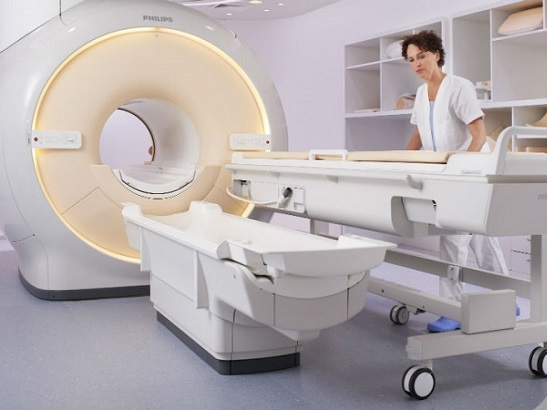
Image: High Intensity Focused Ultrasound (HIFU) machine
Here at the ICR, we’ve pioneered a technology that uses ultrasound to destroy tumours without the need for surgery. Called high-intensity focused ultrasound, or HIFU, the technique uses highly targeted sound waves to heat and destroy cells inside the body.
It’s already showing promise in relieving pain in patients with secondary tumours in the bone and recurrent gynaecological cancers – and could one day be used as a cancer-destroying treatment that also makes treatments like immunotherapy and radiotherapy more effective.
“Focused ultrasound is exciting because it can target tumours very precisely,” explains Professor Gail ter Haar, Professor of Therapeutic Ultrasound at the ICR.
“The point onto which the ultrasound beam is focused gets very hot, but the surrounding tissue is left unharmed. It’s like using a magnifying glass in the sun to start a fire, where you need to form a sharp focal spot on the dry tinder.”
Trailblazers
Professor ter Haar has been leading the field of HIFU research for decades.
“When I joined the ICR, there was some research into the effect of heating cancer cells to make them more sensitive to radiotherapy,” she says. “But by increasing the temperature to 56°C, for just a second, we found we could actually kill the cells directly.
“After a lot of pre-clinical work, we built our own prototype machine, and used it to treat a small number of patients with liver cancer.”
Her work formed the basis of a fully-fledged HIFU system, developed in China, that is still in use in Oxford today.
Our plans for our immunotherapy research are ambitious – but with your support today, we can make these plans a reality and give greater numbers of cancer patients a vital extra lifeline.
Working together
However, early HIFU machines used ultrasound imaging to guide the treatment, which couldn’t be used at the same time as the beam. That limits the potential of HIFU as a curative treatment, because the beam needs to be targeted very precisely.
To overcome that obstacle, in 2004 Professor ter Haar turned to Professor Nandita de Souza, Professor of Translational Imaging at the ICR and lead academic radiologist at the ICR and our partner hospital, The Royal Marsden NHS Foundation Trust.
Professor de Souza is an expert in magnetic resonance imaging (MRI), which uses magnets to see inside the body.
“Much of my research is around using MRI to improve treatments for patients,” she says. “This seemed like the perfect fit.”
Working with the Focused Ultrasound Foundation, they were able to secure the equipment they needed from technology and healthcare company to adapt an existing MRI machine at The Royal Marsden for HIFU, and began a trial treating patients with late-stage cancer who had painful bone metastases.
“Some of these patients were in such pain that they were unable to extend their arm, or even sit down,” says Professor de Souza. “Using HIFU, we were able to destroy the nerve cells around the tumours, relieving the pain.”
Improving lives
With the first trial showing that the machine works as expected, Professor de Souza is now recruiting for a new trial, using HIFU to target tumours directly in patients with recurrent gynaecological cancer.
“These women have no other treatment options, so we’re looking to improve their quality of life, either by reducing their pain, or by reducing their bleeding,” she explains.
It’s a challenging job, as the ultrasound focus must avoid any of the surrounding organs, such as the bowel.
“We’ve treated six patients so far, and we’ve already had some good results,” she says. “I’m hopeful the trial will show that HIFU can improve these patients’ quality of life.”
Search is our twice-yearly newsletter to supporters. Read our latest news, recent research achievements and interviews with our world-leading scientists and clinicians.
Going further
In future, Professor ter Haar believes, HIFU could be an even more versatile treatment.
One area of particular promise is to use the technology along with radiotherapy. Heating cancer cells increases their sensitivity to radiation, so combining HIFU with radiotherapy could be an effective way to treat cancer.
“We’re already looking at ways to target the areas of tumours that radiotherapy can’t treat alone,” Professor ter Haar says. “Combining the two could be more effective than using either one alone.”
Her team is carrying out complex work that could lay the groundwork for this combination of treatment.
For example, they recently built a ‘virtual’, computerised tumour that accurately mimics the effects of HIFU on cancer cells.
This will play an important role in helping Professor ter Haar’s team to refine methods for measuring and calibrating combined HIFU-radiotherapy treatments.
Our researchers are continuing to explore the potential of HIFU in other new, and sometimes surprising, ways.
“There’s even evidence that HIFU can trigger the immune system to attack the tumour, supporting other treatments like immunotherapy,” says Professor ter Haar.
HIFU is a pioneering, exciting technology that could be used as a brand new form of cancer treatment in the future – and was developed at the ICR.
Having already shown great promise in treating cancer-associated pain, our researchers are leading trials that could bring it to patients to treat cancers that other treatments on their own can’t cure.
